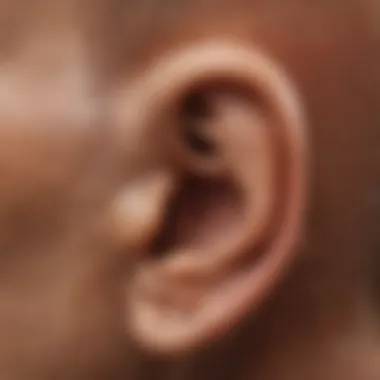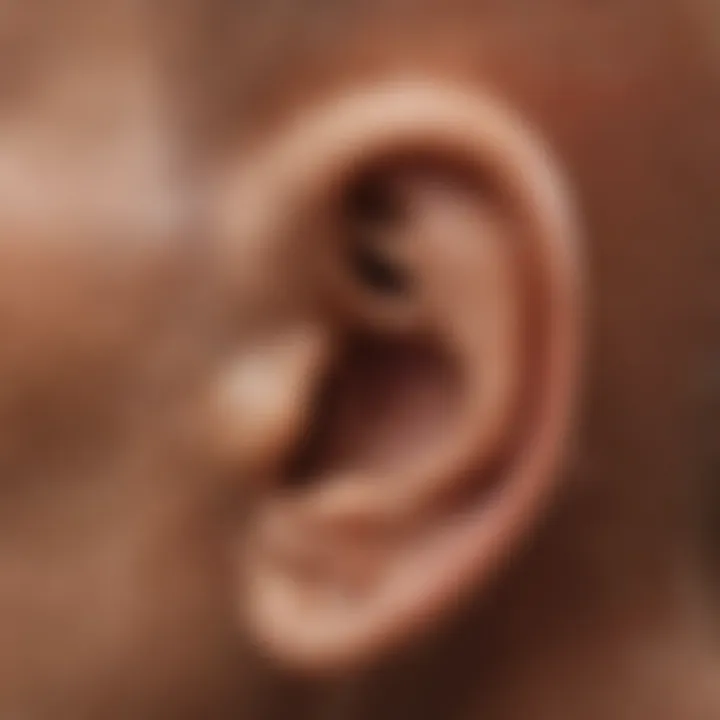Proven Ways to Eliminate Water from Ears Quickly


Intro
Water trapped in the ear can be a pesky nuisance, often leaving individuals feeling uncomfortable and sometimes even dizzy. It's particularly a problem for those who spend a lot of time in the water—swimmers, surfers, and divers commonly face this issue. Interestingly enough, our ears, with their complex anatomical structure, can sometimes retain water, creating an irritating situation that's hard to shake off. Understanding how to effectively remove this water becomes not just a matter of comfort, but also a vital skill for anyone indulging in watersports.
In this article, we detail various effective methods to extract water from the ear, along with preventative measures. The goal here is to equip water sports enthusiasts with not just the know-how to deal with trapped water, but also to share insights into the ear's anatomy and potential complications. So grab your towel and read on for practical tips that could save you from an awkward post-swim experience.
Techniques and Skills
Fundamental Techniques for Beginners
For novices, removing water from the ears can seem daunting, but there are some straightforward techniques that can make this process much easier:
- Gravity Trick: Simply tilt your head to one side, with the affected ear facing down. Gently pull on the earlobe to help facilitate drainage. Sometimes, a simple shake of the head while in this position can encourage the water to flow out.
- Jaw Movements: Open your mouth and move your jaw side to side. When you do this, it can help create pressure changes in the ear, aiding in loosening any trapped water.
- Heat Application: Using a towel soaked in warm water and applying it gently against the ear can help vaporize the trapped water. The warmth aids in relaxing the ear canal.
Advanced Skills for Experienced Athletes
For those who have spent more hours in the water, mastering a few advanced techniques might come in handy:
- Vacuum Method: This involves placing the palm of your hand tightly over your ear, then pushing in and pulling out quickly. This creates a vacuum effect that could draw the water out.
- Ear Drops: Saline drops can be beneficial as they help balance the ear's internal environment. It's worth having these in your watersports first-aid kit.
- Ear Plugs: Equip yourself with waterproof earplugs before diving in. This is a preventive method, making sure you significantly reduce the chances of water going in your ear while enjoying your aquatic activities.
"Prevention is always better than cure. Equipping yourself with the right gear can save you from the discomfort of trapped water."
Safety and Gear
Essential Safety Measures in Watersports
When engaging in any aquatic activity, safety measures should never be overlooked. Here’s a quick checklist:
- Buddy System: Always dive or swim with someone in case of emergencies.
- Be Aware of Your Surroundings: Know the depth of the water and any potential hazards lurking beneath the surface.
- Use Suitable Gear: Ensure your watersports equipment is in good condition.
Gear Reviews and Recommendations
The right gear can enhance your safety and enjoyment. Some top-notch gear to consider includes:
- Mack’s Pillow Soft Silicone Earplugs: These are moldable and provide a custom fit, perfect for swimming.
- Speedo Biofuse 2.0 Ear Plugs: These are designed for comfort and provide excellent protection against water ingress.
Investing in quality gear not only protects you but also enhances your overall experience while engaging with water activities.
Understanding Ear Anatomy
Understanding the anatomy of the ear is paramount when addressing the topic of trapped water. The ear is a complex structure with different components that serve various functions. Familiarity with these elements not only aids in appreciating how water affects the ear but also enhances the effectiveness of removal methods. This knowledge is especially beneficial for those engaging in water sports or recreational activities where water exposure is inevitable.
Structure of the Ear
The ear can be divided into three main sections: the outer ear, middle ear, and inner ear.
- Outer Ear: This includes the pinna and the ear canal. The pinna, the visible part of the ear, acts as a funnel to direct sounds towards the ear canal. The ear canal is a tube that channels sound waves to the eardrum.
- Middle Ear: Behind the eardrum lies the middle ear, housing three tiny bones known as the ossicles. These bones are the malleus, incus, and stapes; they amplify sound waves and transmit them to the inner ear. Additionally, the eustachian tube connects the middle ear to the throat, helping equalize pressure when swallowing or yawning.
- Inner Ear: The inner ear contains the cochlea, a spiral structure responsible for converting sound waves into nerve impulses. It also houses the vestibular system, which helps maintain balance.
Understanding this structure reveals why water can become trapped. Since the ear canal is a closed space, any blockage or pressure differences can prevent water from escaping.
Types of Ears and Their Functionality
Ears can be classified based on their shape and size, which can impact their functionality. Generally, we see:
- Standard Ear: Most people have a standard ear shape, and their functionality aligns perfectly with the structures mentioned earlier. They are efficient in sound reception and balance.
- Cauliflower Ear: Common among wrestlers and contact sport athletes, this condition results from repeated trauma leading to deformity. This type of ear may not channel sound as efficiently, and it could also lead to complications if water gets trapped after sports.
The design of one’s ears can influence how water is retained. Certain shapes may create more crevices for water accumulation.
How Water Can Impact Ear Health
Water trapped in the ear can be more than just a nuisance; it can lead to several health issues. Here are some health implications:
- Ear Infections: When water lingers, it creates a breeding ground for bacteria and fungi. This can result in outer ear infections, often called swimmer's ear.
- Diminished Hearing: A significant amount of water can muffle sounds, leading to temporary hearing loss until it clears.
- Tinnitus: Some people may experience ringing in the ears if trapped water irritates the ear structures.
Understanding water's impact on ear health underscores the importance of timely removal strategies to prevent long-term effects.


In summary, a solid grasp of ear anatomy is essential to effectively address the problem of water retention in the ears. Knowing how these structures work together not only informs removal methods but also helps in taking preventative measures. This understanding is particularly crucial for individuals who frequently engage in water-related activities.
Common Scenarios for Water Trapping
Understanding the scenarios in which water becomes trapped in the ear is essential to mitigate discomfort and prevent complications. Water ingress in the ear can lead to irritation, potential infections, and even long-term health risks if not addressed properly. For water sports enthusiasts and outdoor adventurers, identifying these scenarios is vital; it helps in making informed decisions before, during, and after aquatic activities. Knowing where and when water might enter the ear can empower individuals to use preventive measures effectively or apply the right techniques to remove it promptly.
Activities Leading to Ear Water Retention
Certain activities are notorious for causing water to pool in the ear canal. Simple actions can lead to this uncomfortable situation, particularly if one is frequently submerged. Here are some common activities where water retention is a likely outcome:
- Swimming: Whether it's in a pool, lake, or ocean, water often enters the ears during dives, jumps, or even casual splashing about.
- Surfing: As waves crash and a surfer navigates through the water, the risk of water getting into the ears increases significantly.
- Diving: Diving deeper into the ocean exposes the ear to greater water pressure. If proper equalization techniques aren’t used, decompression can create a vacuum effect, retaining water once surfaced.
- Showering: It's surprisingly easy for water to trickle in during a shower, especially if one tilts their head or moves around a lot while washing.
Awareness of these activities can help form strategies to reduce water entry, such as wearing protective gear or utilizing earplugs.
Environmental Factors Contributing to Water Entry
Besides specific activities, environmental factors can facilitate water retention in the ear. Understanding these elements can lead to better preventive measures and enhance ear care. Consider the following:
- Humidity: A humid environment often makes it easier for moisture to accumulate in the ear. This is particularly true for individuals engaging in water activities in tropical or rainy regions.
- Wind: Strong winds can create splashes or gusts that carry water directly into the ears, especially for those participating in activities like sailing or kite surfing.
- Temperature Changes: Rapid changes in temperature can cause condensation within the ear canal. This is particularly observed post-swimming when the body temperature and water temperature differ significantly.
"Being proactive about understanding the environments and activities you engage in can dramatically change your ear care regimen."
Taking note of these environmental factors will aid in minimizing water retention incidents. Whether one is swimming or taking a leisurely boat ride, being aware of the conditions can help one strategize effectively.
Immediate Solutions to Remove Water
Encountering water trapped in the ears can be a vexing problem, especially for those who take a dip in pools or plunge into the ocean. Immediate solutions to remove water are vital not just for comfort but also to prevent further issues such as infections or hearing loss. By quickly addressing the situation, individuals can alleviate discomfort and potentially avoid complications down the line.
Gravity Method
Instructions
Using the gravity method is a straightforward way to dislodge water. To perform this technique, first, tilt your head to the affected side so that the ear in question faces downward. Then, you should gently tug on the earlobe, which may help to straighten the ear canal, allowing the water to drip out more easily. You can even jump slightly if you feel adventurous—sometimes a bit of movement can help shift that stubborn water out. The key characteristic of this method is that it relies solely on the laws of physics, making it a popular choice due to its simplicity and lack of required tools.
While the gravity method is usually safe, it can sometimes result in discomfort if one has an ear condition. It��’s important to be cautious and attentive while using this method to ensure you don’t cause any additional strain.
Effectiveness
The effectiveness of the gravity method largely hinges on the angle of the head and the position of the ear canal. For many, this method can result in the quick release of trapped water. However, it does have a drawback; in some cases, if the water is stuck deeper or if the canal is curvy, the technique may not work. Still, it’s often one of the easiest and most common first attempts at removing water from the ear without resorting to more complicated methods.
Jaw Movements and Head Tilting
Technique Overview
Jaw movements and head tilting can provide an unexpected yet effective approach for removing trapped water. By moving your jaw in a chewing motion or even yawning while tilting your head to the affected side, you can create a shift in pressure within the ear canal. This method capitalizes on the connection between the jaw and the ear, specifically how the movement can alter the ear canal’s shape. Many people find this method advantageous since it’s both discrete and natural. However, as with any method, it's best to remain aware of your body’s response to ensure you don't cause any discomfort.
Limitations
Despite its potential benefits, there are limitations to consider with jaw movements and head tilting. Not all individuals find this technique effective, especially if the water is trapped in such a way that mechanical movement doesn’t help. Additionally, those with TMJ disorders may find this method uncomfortable. Individuals should also recognize that results vary; for some, this method may provide immediate relief, while for others, it could lead to frustration if no progress is made.
Using a Blow Dryer
Safety Considerations
Using a blow dryer can be a practical solution for removing trapped water, but several safety considerations must be factored in. First, always set the blow dryer to the lowest heat setting and maintain a distance of at least 12 inches from the ear. This distance helps prevent potential burns and ensures the warm air gently evaporates the moisture trapped inside. Moreover, never use the blow dryer while your ear is wet or if there is any pain or fluid leakage, as this could indicate a more serious underlying issue that requires professional attention.
Best Practices
To make the most out of using a blow dryer, it’s best to position the device so that the airflow directly targets the outer ear. Stand in a comfortable position and let the warm air flow over the ear for a few minutes. This technique often leads to effective results by facilitating evaporation. However, like any method, there are caveats. If you feel any discomfort, or if you are unsure about your situation, stopping and reassessing is crucial. Patience is key here, as not all trapped water will come out immediately.
Saline Irrigation Technique
Procedure
Saline irrigation is another method that can provide notable relief. This technique involves using a saline solution, ideally purchased at a pharmacy or prepared at home. The procedure consists of tilting your head over a sink, gently squeezing the saline solution into the affected ear, and allowing it to drain out after a short period. The saline acts to not only help flush out any trapped water but also to clean the ear canal. This method is beneficial because it incorporates a cleaning element along with the primary goal of water removal.


Effective Outcomes
The effective outcomes of saline irrigation can be quite favorable, particularly for those who often find themselves battling ear water after swimming. This method can not only help remove stuck water but also has the additional advantage of helping to ward off possible infections, making it particularly relevant for individuals sensitive to such issues. However, it’s essential to be mindful that not everyone responds similarly; some may find it beneficial, while others may prefer alternative choices if they encounter irritation.
Water trapped in the ears can turn a delightful swim into an uncomfortable experience. By diving into these immediate solutions, you are better equipped to tackle the issue head-on and reclaim your comfort.
Home Remedies for Persistent Discomfort
Dealing with lingering feelings of fullness or discomfort from water stuck in the ears can be a real nuisance, especially for those who frequently indulge in water sports or spend time swimming. Home remedies serve as convenient and effective options for alleviating these pesky sensations without the need for specialized interventions. Learning to manage water retention at home not only promotes personal health but also empowers individuals to take charge of their ear care.
When discomfort persists, turning to natural solutions often proves beneficial. Many folks prefer these remedies due to their accessibility, affordability, and minimal side effects. Simple household items can offer a degree of reassurance, as they allow for immediate personal care before considering professional assistance. Below, we delve into two popular home remedies that stand out in their ease of preparation and effectiveness.
Alcohol and Vinegar Solution
Preparation
Using an alcohol and vinegar solution is a popular home remedy for solving the discomfort of trapped water. The preparation of this mixture is straightforward, requiring equal parts of isopropyl alcohol and white vinegar. This simple concoction boasts a dual function: it helps dry out moisture and maintains a balanced pH in the ear canal. Many people value it for being a cost-effective option and readily available at home, making it an excellent first line of defense against persistent water.
The unique characteristic of this solution lies in its quick-drying properties, which can be incredibly beneficial for those who want instant relief after coming out of the water. Nonetheless, those with sensitive ears should take caution when using this remedy.
Application
Applying the alcohol and vinegar solution requires the utmost respect for safety. To use the remedy effectively, tilt your head to the side and administer three to four drops of the mixture into the affected ear using a dropper. Allow it to sit for about 30 seconds before tilting your head in the opposite direction to let it drain out.
This method is popular because it combines the drying qualities of alcohol with the antibacterial properties of vinegar. The remarkable feature of this application is the rapid evaporation of alcohol that can help alleviate the feeling of clogged ears swiftly. Still, people must be cautious about overuse, as excessive application could lead to irritation.
Over-the-Counter Drops
Product Recommendations
As the name suggests, over-the-counter drops stand as an appealing solution for many facing water retention issues. These products, like Debrox and Murine Ear Drops, are widely recognized for their ability to break up earwax while also helping remove trapped moisture. Recommended for their ease of use, they often come in pre-measured bottles that allow for proper application—ideal for those who seek effective remedies without the fuss.
The primary advantage of these drops is their targeted action and formulation tailored to sustaining ear health. However, researching individual product labels for specific ingredients is necessary to avoid any adverse reactions.
Usage Guidelines
To get the most out of over-the-counter drops, following the dosage instructions provided on the packaging is crucial. Generally, the recommendation includes placing a few drops into the ear, leaving it for a few minutes, and then allowing it to drain out. For frequent swimmers, utilizing these drops post-water exposure may help maintain comfort.
The ease of dosage and clarity in instructions make these drops likable for many. However, potential side effects, such as irritation or sensitivity in some individuals, should not be overlooked when using these products, therefore should conduct a patch test beforehand to gauge any reactions.
"Regularly addressing the discomfort caused by trapped water can save you from potential ear infections and other complications."
Home remedies are an effective step towards maintaining ear health and reversing pesky sensations. By integrating measures like the alcohol and vinegar solution or over-the-counter drops into your routine, you can navigate the muddy waters of discomfort safely and effectively.
Preventative Measures for Water Retention
When it comes to enjoying water activities, taking some precautions can save you from the discomfort of water trapped in your ears. Being proactive isn’t just a good idea; it’s essential for maintaining ear health and preventing the irritations that come with water retention. Addressing water in the ears often starts with recognizing how it enters in the first place, and by taking the right steps beforehand, the problem can be drastically minimized.
Earplugs and Custom-Fitted Devices
Types of Earplugs
Using earplugs designed for water activities can make a world of difference, and there are various types available on the market. Silicone earplugs are popular for their soft material and comfortable fit, forming a seal that effectively keeps water out while remaining comfortable for prolonged wear. Additionally, flanged earplugs offer a more secure fit due to their multi-layered design, making them a favored choice among swimmers.
The key characteristic of silicone earplugs is that they provide a snug fit around the ear canal, which is crucial in preventing water penetration. However, flanged varieties are lauded for their versatility—they can often be used for a variety of water-related activities. Each type has its own advantages, and choosing the right earplug can be a game changer.
Choosing the Right Fit
Having the right fit is vital when using earplugs; poorly fitted plugs can easily fall out or fail to seal, allowing water to sneak in. To highlight this, custom-fitted earplugs are often regarded as the best option for serious water enthusiasts. These earplugs are molded to fit the unique shape of your ear, which not only provides a superior seal but often ensures that they can be worn comfortably for long periods.
A snug fit reduces the likelihood of leakage, making custom plugs a wise investment for frequent swimmers or divers. Yet, it’s worth noting that they can be more expensive than standard options, which could be a consideration for those just starting out in water sports.
Post-Activity Cleaning Techniques
Importance of Drying


Once activities are done, drying your ears should be a priority. Ignoring this could lead to trapped moisture which may cause irritation or infections down the line. After swimming or diving, gently drying out the ears with a soft towel can help remove excess water.
The importance of this shouldn’t be understated—it’s a straightforward method that can protect against discomfort and prevent conditions like swimmer’s ear. By adopting this habit, you're not only tackling the issue of trapped water but also taking significant steps towards maintaining ear health.
Recommended Products
Besides simple towel drying, there are several products designed specifically to assist with ear drying. Ear drying drops, containing isopropyl alcohol, can help evaporate trapped moisture quickly and effectively. These products often come in dropper bottles which make application simple and precise.
Using these drops can be a practical choice, particularly after prolonged exposure to water. However, it’s crucial to read the ingredient list—some products may not be ideal for sensitive skin or could cause irritation. Furthermore, overusing drying drops can potentially lead to dryness discomfort, so moderation is key.
"An ounce of prevention is worth a pound of cure."
In summary, taking preventative measures against water retention is key for anyone who enjoys water activities. Be it fitting earplugs properly or incorporating drying techniques, these actions can safeguard your ear health and enhance your experience in the water.
When to Seek Professional Help
Water trapped in the ear often feels like a minor nuisance. However, for some individuals, it can lead to more serious issues. Knowing when to seek professional help can keep you from facing long-term damage or complications that arise from a simple irritation. Ignoring persistent water retention may escalate into infections or other concerns that necessitate medical intervention. Understanding the potential symptoms and when to take action assures individuals engaging in water activities that they are practicing diligent ear care.
It's vital to not brush off strange sensations in the ear. Dive deeper into the signs that indicate it might be high time to consult a healthcare provider.
Identifying Symptoms of Infection
When water gets trapped in the ear, it can create a favorable environment for bacteria or fungi to thrive. Some troubling signs to look out for include:
- Persistent Discomfort: If you feel aching that doesn't fade after a few hours.
- Fluid Drainage: Noticing any fluid coming out that has a foul odor.
- Hearing Changes: If sounds seem muffled or you experience ringing (tinnitus).
- Fever: Elevated body temperature accompanying any ear discomfort.
If you see these symptoms, it's prudent to schedule an appointment. Untreated infections can lead to long-term complications. Additionally, the pain may worsen or additional symptoms can appear, possibly affecting balance and overall health.
Professional Cleaning Procedures
In some cases, a simple home remedy might not cut it and professional cleaning could be the best solution. There are specific methods healthcare providers use to clear stubborn water:
- Ear Irrigation: The provider uses a syringe-like tool to gently flush out the ear using warm water or saline solution.
- Suction: A vacuum-like device can suck out excess moisture and debris safely.
- Manual Removal: In certain cases, the doctor may directly remove water using specialized instruments.
Consulting a healthcare professional not only effectively resolves the issue but reduces the risk of further complications, ensuring that the ear remains healthy. The provider can also assess any damage that may have occurred from prolonged moisture exposure and provide personalized advice on ear care.
Remember, your ears are delicate. If something feels off, don’t hesitate to seek help.
Final Thoughts on Ear Care After Water Activities
Taking part in watersports and other outdoor activities that involve water can be both exhilarating and refreshing. However, the experience can be tainted when water gets trapped in the ears. It is crucial to recognize that ear care following these activities is not merely an afterthought but an essential practice that can prevent discomfort and potential health issues.
Water that lingers in the ear canal creates a comfortable environment for bacteria and fungi, leading to infections like swimmer's ear. Thus, reinforcing the importance of ear hygiene becomes imperative. Maintaining clean, dry ears not only supports overall ear health but also aids significantly in enjoying your aquatic adventures free from the woes of infection and irritation.
The Benefits of Proper Ear Hygiene
- Infection Prevention: This is key! Cleaning your ears routinely helps prevent bacteria from thriving in damp conditions.
- Enhanced Comfort: Who wants to spend their day with a troubling sensation in their ear? Regular cleaning ensures you can focus on having fun instead of discomfort.
- Improved Hearing: When water isn't stuck behind earwax or other debris, it allows for clearer hearing, essential when you're in a social environment or even for safety in the water.
In addition to prevention, understanding how to balance enjoyment with ear health is equally vital. The balance involves knowing when to take protective measures and the best practices to engage in post-activity care. Ignoring these elements can lead to more severe problems down the road, impacting one's ability to enjoy water activities.
"Taking care of your ears today can save you from discomfort tomorrow."
The Importance of Ear Hygiene in Watersports
Gold's don’t always sparkle, and similarly, fun in the water can hide numerous threats to ear health. Engaging in water activities means facing potential entry points for water in the ears. Whether swimming, kayaking, or paddleboarding, water can easily seep in, causing discomfort or leading to infections if not addressed.
Practicing good ear hygiene means regular cleaning and maintenance, especially after exposure to water. With the right knowledge, users can easily understand the risks involved and take proactive steps toward prevention.
- Post-Swim Ear Flushing: After each session, it is wise to flush your ears out gently with water or saline solution to clear any remaining water.
- Use of Earplugs: Particularly during intense water activities, consider using earplugs designed for swimming. They reduce water entry substantially.
- Maintenance of Clean Tools: Regularly cleaning swim gear or any devices that might come into contact with water can aid in keeping the ears healthy.
Taking these simple steps can make a remarkable difference in maintaining ear hygiene in watersports.
Balancing Enjoyment and Ear Health
While the thrill of watersports often calls to enthusiasts, finding a middle ground between fun and health is paramount. Most adventurers aren't aware that neglecting ear care can have lasting effects. Striking this balance means integrating practices into one's routine that don’t detract from enjoyment but enhance it.
- Scheduled Breaks: Consider scheduling breaks during prolonged activities to check in on your ear comfort. Taking a moment to clear your ears or dry them off can make a world of difference.
- Hydration Awareness: Often, staying hydrated will keep your body functioning optimally, which includes ear function. Dehydration can lead to thickening of ear wax, potentially trapping water.
Being mindful of such simple methods can greatly improve overall experience, leading to longer-lasting enjoyment of both the activity and a healthy ear condition.
In summary, ear care is often overlooked in the face of adventure, yet it remains an essential element for all water enthusiasts. Making the effort to prioritize ear hygiene is not just prudent but necessary for continued enjoyment of aquatic activities.















